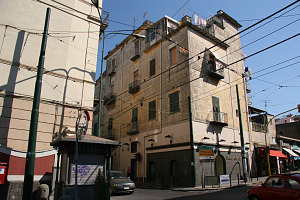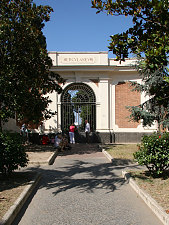The next couple of days were spent poking about in Avellino. Aunt Rosetta hosted several wonderful lunches, with great cooking. At breakfast time, I was very honored to be offered to use the cup that my late uncle Peppino used to use for his coffee. Jenn and I wandered the grounds of the house, relaxed a bit, and had a fun little afternoon lawn-chair sit-around with various cousins and aunts. I was even able to muster enough Italian to have a discussion about politics with my Aunt Sisina!
Spacious downstairs accommodation
We made frequent trips out with Mom, doing various errands, some shopping, and, of course, visiting family. As usual, my mother complained about how horrible the traffic was in Avellino, but, you know, I don't really find it that bad. One needs to adopt a different... mindset, shall we say, and then everything flows quite smoothly.
Andrew, Paolo and the three sisters
We had two delightful visits with two of my Aunts. One was at my Aunt Amelia's house, situated in a little mountain town looking down on Avellino. My Aunt Amelia is 96 years old, and still she was out in the garden to greet us, and walked us to the front gate to see us off when we left. The other visit was to my Aunt Sisina's flat in downtown Avellino. I quite like her apartment - I find it a mix of quiet elegance and contemporary European style. We spent the morning there, sipping orange pop and biscuits, and going over (of all things) photo albums of the Lavigne family growing up in northern New Brunswick.
Jenn and Mom in downtown Avellino
Andrew inserted into the mix
In Italy, looking at Canada
Our time while staying in Avellino was not completely consumed by relaxation and family visits. Jenn and I made several day trips out of Avellino, visiting the ruins of Herculaneum, the palace of Caserta, and the highest point in the nearby Picentini mountains.

Historic Vesuvius
I'd been meaning to visit Herculaneum for some time now. I've seen the ruins of [famous] Pompeii multiple times now, and while it is interesting, my understanding was that Herculaneum was not to be missed. Herculaneum is/was a Roman town that was destroyed by the same 79AD eruption of Vesuvius that destroyed Pompeii. Herculaneum was, however, not as badly damaged as Pompeii was. Additionally, Herculaneum was discovered more recently, meaning that better archeological techniques were applied to the city. The ruins are therefore in better shape than at Pompeii. Herculaneum resides underneath the present-day town of Ercolano. Ercolano lies beneath Vesuvius on the coast of the Gulf of Naples.

Modern-day Ercolano
Ercolano is only about 45 minutes drive from Avellino. It is a typical vibrant southern Italian town, with lots of hustle and bustle, scooters and minicars, cafes and tourists. The ruins are right in the downtown area, marked with a faux roman-classical style entrance that says 'Herculaneum' in classical roman script.

Entrance to Herculaneum ruins
We encountered a bit of classical Italian inefficiency here as well. A sign on the entranceway stated that a 'staff meeting' was occuring and all employees at the ruins were attending. Meaning, of course, that the ruins would be not be opening until they came back.

Exasperated visitors
The appointed time for the staff to return came and went, and the couple of visitors waiting at the entrance grew to a restless crowd. The morning slowly ticked away, and the crowd grew ever larger. Finally, not long before noon, the gates were finally opened, and we made our way in.

Herculaneum overview
The pyroclastic flow that engulfed Herculaneum ended up completely burying the city in a fairly solid mass of rock. When you enter the ruins, you see it stretched out far below you (perhaps 20m - 60ft). The way down into the ruins circles around on slopes, ramps, and tunnels, until you are finally at the lowest point of the ruins: the ancient porticos that marked the sea-edge of the city. Inside these vaulted openings were discovered the bones of the residents of Herculaneum, who apparently realized doom was upon them and fled to what they thought might be a safe refuge from the eruption.
[ Italy 2005 trip
home page |
The main trip report |
Family |
Monte Cervialto |
Herculaneum & Vesuvius |
Palace of Caserta |
Amalfi & Capri |
Abruzzo & Monte Amaro |
Rome |
Tuscany |
Venice |
The Biennale |
Via Ferrata-ing in the dolomites |
Climbing in the Ortles |
Gottfried's Adventures |
Maps, Graphs & GPS Data ]